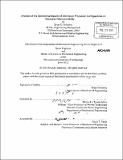| dc.contributor.advisor | Michael S. Triantafyllou. | en_US |
| dc.contributor.author | Heberley, Brian Douglas. | en_US |
| dc.contributor.other | Massachusetts Institute of Technology. Dept. of Mechanical Engineering. | en_US |
| dc.date.accessioned | 2011-12-19T18:50:32Z | |
| dc.date.available | 2011-12-19T18:50:32Z | |
| dc.date.copyright | 2011 | en_US |
| dc.date.issued | 2011 | en_US |
| dc.identifier.uri | http://hdl.handle.net/1721.1/67780 | |
| dc.description | Thesis (Nav. E. and S.M.)--Massachusetts Institute of Technology, Dept. of Mechanical Engineering, 2011. | en_US |
| dc.description | Cataloged from PDF version of thesis. | en_US |
| dc.description | Includes bibliographical references (p. 137-139). | en_US |
| dc.description.abstract | In an effort to develop submarine designs that deliver reduced size submarines with equivalent capabilities of the current USS VIRGINIA (SSN-774 Class) submarine, a joint Navy/Defense Advanced Research Projects Agency (DARPA) called the Tango Bravo (TB) program was initiated in 2004 to overcome technology barriers that have a large impact on submarine size and cost. A focus area of the TB program is propulsion concepts not constrained by a centerline shaft. This thesis investigates the operational impacts that a conceptual propulsion configuration involving the use of azimuthing podded propulsors has on a submarine. Azimuthing pods have been used commercially for years, with applications on cruise ships being quite common although their use on large naval platforms has been nonexistent to date. The use of such systems on a submarine would allow for the removal of systems related to the centerline shaft; freeing up volume, weight, and area that must be allocated and potentially allowing the submarine designer to get outside the speed-size-resistance circular path that results in large, expensive platforms. Potential benefits include having the pods in a relatively undisturbed wake field -possibly increasing acoustic performance as well as improving operational maneuvering characteristics. For this thesis a submarine maneuvering model was created based on analytical techniques and empirical data obtained from the DARPA SUBOFF submarine hullform. This model was analyzed for two configurations: ** A centerline shaft configuration utilizing cruciform control surfaces for yaw and pitch control; ** A podded configuration utilizing pods for propulsion as well as yaw and pitch control. The maneuvering characteristics for each configuration were investigated and quantified to include turning, depth changing, acceleration, deceleration, and response to casualties. | en_US |
| dc.description.statementofresponsibility | by Brian D. Heberley. | en_US |
| dc.format.extent | 139 p. | en_US |
| dc.language.iso | eng | en_US |
| dc.publisher | Massachusetts Institute of Technology | en_US |
| dc.rights | M.I.T. theses are protected by
copyright. They may be viewed from this source for any purpose, but
reproduction or distribution in any format is prohibited without written
permission. See provided URL for inquiries about permission. | en_US |
| dc.rights.uri | http://dspace.mit.edu/handle/1721.1/7582 | en_US |
| dc.subject | Mechanical Engineering. | en_US |
| dc.title | Analysis of the operational impacts of alternative propulsion configurations on submarine maneuverability | en_US |
| dc.type | Thesis | en_US |
| dc.description.degree | Nav.E.and S.M. | en_US |
| dc.contributor.department | Massachusetts Institute of Technology. Department of Mechanical Engineering | |
| dc.identifier.oclc | 767586933 | en_US |
